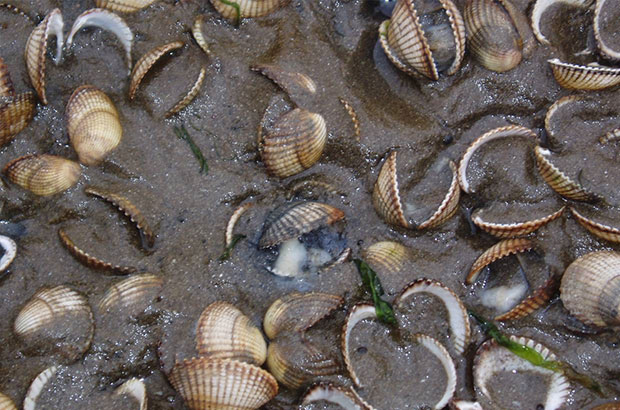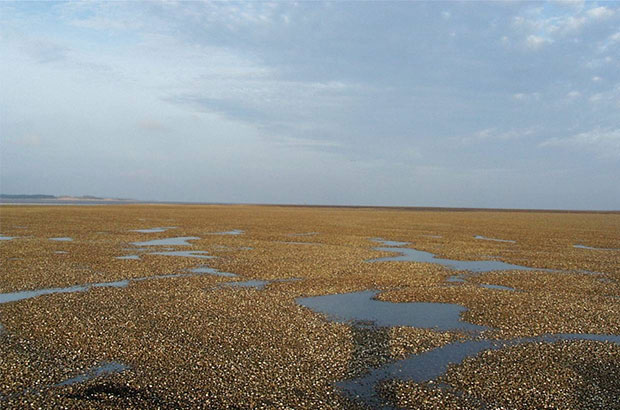Mortalities in populations of edible cockles (Cerastoderma edule) have been reported across Europe in the past two decades from Spain, Portugal, France, Sweden and the Wadden Sea. Why are they happening?
There are many suggestions. These include adverse weather conditions and exposure, pollution and eutrophication, loss of genetic diversity and habitat, predation and disease. But few studies have taken an integrated approach to the problem. Often the reasons for the mortalities reflect the specialism of the laboratory involved in the investigation.
Since 2002, chronic mass mortalities have been observed annually within the commercial cockle beds in the Burry Inlet, Carmarthen Bay, with the bulk of mortalities happening since 2004.

These have resulted in heavy financial losses to the commercial fishery (estimated £3m a year), but have impacted the nature conservation interests of the Burry Inlet. Oystercatcher (Haematopus ostralegus) - a species feature of the Burry Inlet Special Protection Area (SPA) and Ramsar Site - are specialist feeders which rely on cockle for food during winter. A lack of cockles has forced them to forage outside the SPA. And overall numbers in the area have declined. So the cockle mortalities have adversely affected the integrity of this important European and International Site.
Cross agency investigation
So a 2-year investigation was completed in 2011. This was requested and financed by the Welsh Government (WG) and led by the Environment Agency Wales (EAW) - with support from the Countryside Council for Wales (CCW), the Centre for the Environment, Fisheries & Aquaculture (Cefas), and Hull, Bangor and Swansea Universities.
Much progress has been made to explain the mortality mystery. Following similar unusual cockle mortalities, in the Netherlands and the Wash, a Dutch researcher confirmed non-native protozoans were responsible for the identical pathologies of mixed infection patterns. These newly discovered parasites are now present in South Wales, the Wash and the Netherlands. They are thought to have either been solely responsible for, or a significant contributor to, the respective cockle mortalities.
This article provides information about these possible causative agents of the recent mortalities of cockles in the UK. We detail the presence of three non-notifiable haplosporidian parasites, two of which are apparently non-native. How much these pathogens have spread to date is unknown. And concerns regarding movements of animals known to be infected with these potential pathogens have been raised. In particular where there are currently no biosecurity measures in place to prevent the further spread of these non-native parasites. Furthermore, there are serious shortcomings and defects in the legislative framework of biosecurity in wild shellfish fisheries.
New parasite discoveries
Cefas have for many years regularly examined histological cockle samples from the Burry Inlet to determine their health status. During the Summer of 2009 an integrated, intensive sampling programme was carried out in the Burry Inlet to discover the root cause of the mortalities. Lower level mortalities have also been recorded in the nearby Three Rivers Estuary. Cefas lead the aspects of the project relating to individual cockle biology, assessing both the health and reproductive status of the animals collected. Concurrent samples for molecular analysis were collected during the Burry and Dee surveys.
Mortalities tend to occur in 1 year old cockles and, as a result of annual mortality events in the estuary, the population is now mainly comprised of a single cohort of cockles in each year. This has led to an unsustainable fishery and the near collapse of the local cockle fishing industry. More recently, mortalities have been reported in The Wash and in The Netherlands.
In each case, mortalities in other species in these systems have been limited - suggesting that the problem is cockle specific. Indeed, samples analysed by Cefas strongly implicate disease as a contributory factor, with around 30 different infections being noted in these animals at high prevalence and intensity. Mixed infections with several pathogens was a common feature of cockles from the Burry Inlet. In other cockle populations there are generally fewer infections, which occur at lower prevalence and intensity.
Three parasites identified
Subsequent molecular analysis of a sub-sample of cockles from the Dee and Burry Inlet, exhibiting pathological changes consistent with a haplosporidian infection, revealed the presence of three different parasites, namely:
- Minchinia tapetis. This was originally reported from the clam (Ruditapes decussatus) in Spain in the 1950s and has subsequently been associated with mortalities in this species in Spain, Portugal and France. It was also noted by histological analysis in the golden delicious carpet shell (Venerupis aurea) collected in Portugal, causing a marked inflammatory reaction.
- Minchinia mercenariae. This was described from the American hard clam (Mercenaria mercenaria) in which a similar inflammatory response was noted.
- Haplosporidium edule. This was described from the edible cockle in Portugal where it has been reported as causing lesions similar to those found with Minchinia spp. and other haplosporidians.
Two reports of mass mortalities of cockles in Spain and Portugal were attributed to a condition referred to as “large foci of heavy haemocyte infiltration”. Examination of the histology images provided clear evidence of a haplosporidian infection within these inflammatory lesions. However authors of both reports failed to recognise these parasites.
Recent communications with scientists in the Netherlands have also shown the presence of mixed infections with haplosporidians in samples of cockles undergoing mortalities in the Wadden Sea. There are currently no known chemotherapeutants for these infections in molluscs and no data on efficacious disinfectants. Data on lifecycle stages and alternate hosts is lacking; the apparent ability of the Minchinia spp. to co-infect and to cross species boundaries gives rise for concern.
Changes over time
Following reports of a mortality event in the Wash, two samples of cockles were submitted for analysis to the Cefas laboratory. Examination of these samples by histology revealed the presence of large inflammatory lesions at a prevalence of around 60%. Early developmental stages of haplosporidians were noted within the lesions. Few other pathogens of note were observed in these animals. Other than a single example of disseminated neoplasia due to a virus, no evidence was seen for a viral aetiology in the mortality. There is strong circumstantial evidence that the haplosporidian infections may be a major contributory factor in the observed mortalities in the Wash and in the estuaries of Carmarthen Bay.

It is interesting and concerning that samples from 1999 had no evidence of a Minchinia infection, and only 13 parasite species were noted. Data collected by Brian James (University of Swansea) in the late 1960s suggests that around the same number had previously been recorded. Data collected by Cefas subsequent to 2003 has recorded in excess of 25 infections, including Minchinia spp..
This stepwise change, resulting in these large numbers of infections recorded post-2003, does most probably reflect a real increase in infections in the Burry Inlet between 1999 and post-2003. An external source of these infections is the mostly likely cause, considering that the Burry Inlet cockle fishery was closed for 18 months between 2001 and 2002. However shellfish processing continued in the nearby factories. Therefore it is highly likely that diseased cockles were imported and their untreated effluent discharged into the Burry Inlet.
Biosecurity problems
Biosecurity measures are incredibly difficult to apply in estuarine and open marine environments. The greatest risk of introducing disease comes with movements of live shellfish. Also disease can be introduced and spread through other routes to shellfish areas, eg transfer by soiled vehicles, equipment and footwear.
For the Burry Inlet cockle fishery, it is too late for disease prevention. The disease is present within the fishery and it is impossible to control, let alone eradicate. However, there are some measures that can be applied and controlled in these areas to prevent the spread of the disease to other shellfish fisheries. These include:
- vehicular access to the site
- transport of personnel and catch by boat to and from the site
- use of fishing implements and other associated equipment, including cockle and mussel bags
- access by local residents, visitors and other water users to the site
- external clothing and footwear
The problem with legislation
Existing legislative frameworks currently offer little help. The Aquatic Animal Health (England and Wales) Regulations 2009 recognised the importance of effective biosecurity measures in restricting disease spread. But they do not apply to any wild aquatic animal harvested or caught for direct entry into the food chain. Other than one which is to be treated as an aquaculture animal, for instance one that is destined for relaying within a Shellfish Several Fishery Order under Section 1 of the Sea Fisheries (Shellfish) Act 1967. Biosecurity for wild shellfish fisheries fall outside any practical and appropriate legislative controls.
Also the pathogens found in cockles of the Burry Inlet are not “listed diseases” and are therefore not notifiable. Little is known about the life cycle of Minchinia spp. - their intermediary hosts, carriers, modes and vectors of disease transmission. This makes the application of strict, precautionary biosecurity measures even more pressing. Live cockles from South Wales are frequently exported as far away as Spain without merchants or processors being aware of the potential risks associated.
The first step in processing shellfish is washing and grading, with effluent arising from this being generally discharged untreated into the adjacent estuarine or marine environment. This is as most shellfish processing plants are located in coastal areas. Also seed mussel is being exported from South Wales for relaying in areas of the Wadden Sea. The risk of transferring pathogens with the seed mussel is obvious. The aforementioned should provide any statutory authority authorising or licensing any aspect of cockle or mussel fisheries in South Wales with a moral dilemma, albeit not a legal one.
Contrary, the CCW (now called Natural Resources Wales (NRW)) has legal responsibilities in respect of all Welsh SSSIs under the Wildlife and Countryside Act 1981 (as amended; most recently by the Countryside and Rights of Way Act 2000). There is a serious risk that the pathogens will be introduced to other intertidal Welsh SSSIs where shellfish fisheries exist and where birds preying on bivalves are ‘legal features’, eg Traeth Lafan and in the Dee Estuary. Consequently, meaningful biosecurity measures were identified by CCW that will be placed as conditions on any SSSI Assent issued to Fisheries Authorities, such as the WG or NRW, so that they in turn can permit – with the same strict conditions – for wild shellfish fisheries to take place within Welsh SSSIs.
Finally Regulation 9(3) of The Conservation of Habitats and Species Regulations 2010 applies in respect of the exercise of any functions of the WG and other ‘Competent Authorities’ (eg NRW) which are relevant to marine conservation so as to secure compliance with the requirements of the EC Habitats Directive of 1992. This applies, in particular, to functions under the Sea Fisheries Acts within the meaning of section 1 of the Sea Fisheries (Wildlife Conservation) Act 1992 (conservation in the exercise of sea fisheries functions).
Next steps
Consequently, and without legal mechanisms to sort the legislative shortcomings, it will require the WG, NRW and Cefas jointly to:
- communicate the disease history of the Burry Inlet to all participants in the shellfish fisheries (fishermen, merchants, processors, fisheries officers, etc.) detailing recommended biosecurity measures
- inform local residents, visitors and other water users (eg bait diggers, net fishermen, anglers and the various boating, canoeing, kite surfing communities etc.) about the potential risk of spreading disease to other coastal areas
Hopefully this article has highlighted the need and will contribute towards that vision.
This article was co written by Dr Siegbert Otto, an independent Environmental & Law Consultant and university lecturer working in Kenya.
For updates please sign up to email alerts from this blog, email me or you can follow us on Twitter @CefasGovUK.